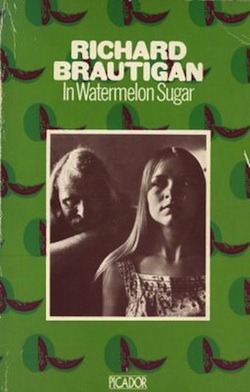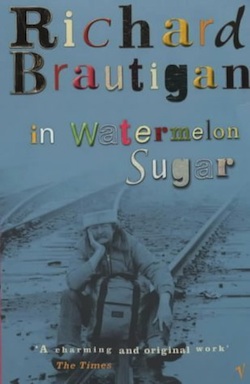Every Tuesday on Tor.com we take a look at books and authors from mainstream literary fiction that contain aspects of science fiction, fantasy, horror and other genre elements. We’re not necessarily claiming these books or authors for the genre camps, but asserting if you like science fiction, fantasy et al., you’ll likely find these books appealing too!
Overall, Genre in the Mainstream hopes to be part of the ongoing discussion about serious literature and how it interacts with artistically sound genre fiction.
Today Richard Brautigan, famously known as the “last of the beats” gives us a completely realized fantasy world in his one-of-a-kind novel; In Watermelon Sugar.
Arguably, Brautigan’s OTHER famous novel is Trout Fishing in America, a book that is most certainly not about trout fishing. In that book, Brautigan appropriates language with surrealist license insofar as sometimes a person can be known as “trout fishing in America” while other times it is a mode of behavior and sometimes whatever metaphor the reader is imaginative enough to insert within the phrase. Superficially, Brautigan is an author who likes playing word games by demonstrating to us that language itself can be fictionalized.
However, while In Watermelon Sugar does contain similar language appropriation and an exploration to discover the meanings of words and our desires behind them, there is a quite literal, even if ethereal, fantasy world depicted here. The book exists out of time, and possibly even out of space. In an unnamed town, sunlight is a different color every day, sometimes red, sometimes grey, sometimes yellow. Nearly everything is manufactured in this town from a substance called watermelon sugar, which is harvested from multi-colored watermelons. (Watermelons are colored differently depending on which day they were harvested.) Most who live in the town congregate near a lodge-type structure called iDeath, which serves as a kind of community meeting place and neutral territory. The narrator of the novel is also unnamed but claims to be writing a book about his experiences at iDeath and with the people who live there.
Beyond having stars that shine different colors and sometimes coalesce into one, the world of In Watermelon Sugar also has a bizarre history. It is revealed fairly quickly that the inhabitants of the town once lived in harmony with talking, mentally evolved tigers. Throughout the town there are statues and lanterns erected in honor of the tigers, even though they are now all extinct. At one point, the narrator recounts the time when the tigers began eating the people, specifically the narrator’s parents.
The reverence all the characters have for the tigers is in direct contrast to the novel’s main antagonist, a character called inBoil. Why Brautigan gives characters and places such bizarre names is never really explained, but there is a slight suggestion that In Watermelon Sugar may take place in some distant, post-everything future, or perhaps even in an alternate dimension. In any case, inBoil and his “gang” live in a place called The Forgotten Works, which contains a variety of old machinery and objects which are mysterious to all the characters who live near iDeath. Here again we’re given hints at some kind of far future world where people have forgotten what certain technology even looks like, and as such are in no position to make it recognizable to the reader. Because In Watermelon Sugar is a very short novel, I’ll not describe what inBoil and his gang are plotting, nor what happens to the narrator. You’ll have to find out.
What makes In Watermelon Sugar such a wonderful and otherworldly read? Like many of Brautigan’s works, he asserts his absurd premises with almost aggressive casualness. Sounds like a paradox, but it’s completely true. If one were to flip through the pages of In Watermelon Sugar each “chapter” appears to be one page, and you might think you’d picked up a collection of poetry, rather than a short novel. But Brautigan has a singular ability to tell a complete and compelling story through a series of small passages, which all on their own are extremely beautiful. If Bradbury had the surrealistic sensibilities of a poet, the towns in Dandelion Wine and In Watermelon Sugar could very well be neighbors. The casual part is that the individual passages of the book look simple and almost child-like. The aggressive part is that these passages contain a weighty story about death, betrayal and love. Talking tigers too.
 But if one ignores talking tigers, different-colored light, and a character named inBoil, there may not seem to be anything fantastical about In Watermelon Sugar. But the simple truth is the act of reading the book does transport the sensibilities of the reader elsewhere. Brautigan doesn’t spend a whole lot of time trying to convince you the world of In Watermelon Sugar is real. But the characters and emotions certainly are. Whenever I read this book, I always imagine I’ve been given an account of a specific incident from an alternate universe. If one could send messages in bottles from alternate universe, I imagine we would often stumble upon ones like this. Where watermelons might not mean watermelon, and tigers might be a different creature all together. All fiction should give us a glimpse into the way an author views his or her own version of the world. It’s a special treat when the world being described is so perfectly odd as this one.
But if one ignores talking tigers, different-colored light, and a character named inBoil, there may not seem to be anything fantastical about In Watermelon Sugar. But the simple truth is the act of reading the book does transport the sensibilities of the reader elsewhere. Brautigan doesn’t spend a whole lot of time trying to convince you the world of In Watermelon Sugar is real. But the characters and emotions certainly are. Whenever I read this book, I always imagine I’ve been given an account of a specific incident from an alternate universe. If one could send messages in bottles from alternate universe, I imagine we would often stumble upon ones like this. Where watermelons might not mean watermelon, and tigers might be a different creature all together. All fiction should give us a glimpse into the way an author views his or her own version of the world. It’s a special treat when the world being described is so perfectly odd as this one.
Ryan Britt is a staff writer for Tor.com.










